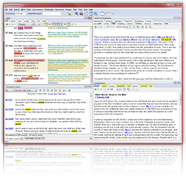Cruse
Cruse
This now obsolete English word denotes a small vessel for holding water or other liquids. Three Hebrew words are thus translated in the A. V. SEE CUP.
1. צִפִּחִת, tsappach'ath (lit. something spread out), is applied to a utensil (usually considered a flask, but more probably a shallow cup) for holding water (1Sa 26:11-12,16; 1Ki 19:6) or oil (1Ki 17:12,14,16). Some clew to the nature of this vessel is perhaps afforded by its mention as being full of water at the head of Saul when on his night expedition after David (1Sa 26:11-12,16), and also of Elijah (1Ki 19:6). In a similar case in the present day this would be a globular vessel of blue porous clay — the ordinary Gaza pottery — about nine inches diameter, with a neck of about three inches long, a small handle below the neck, and opposite the handle a straight spout, with an orifice about the size of a straw, through which the water is drunk or sucked. The form is common also in Spain, and will be familiar to many from pictures of Spanish life. A similar globular vessel probably contained the oil of the widow of Zarephath (1Ki 17:12,14,16). For the "box" or "horn" in which the consecrated oil was carried on special occasions, SEE OIL. Some writers have supposed that the cruse of water mentioned in the first passage (when Saul's life was spared by David) was a clepsydra, or one of those water-watch measures used by the ancients, by which timewas measured by the falling of water from one vessel into another, the undermost vessel containing a piece of cork, the different altitudes of which, as it gradually rose upon the rising water, marked the progress of time. But we can hardly suppose that such time measures were known at that early period. It is usual for persons in the East in the present day, when they travel, to take with them a flask for holding water, and also, when they sleep in the open air, to have a small vessel of water within their reach (Thomson, Land and Book, 2:21). These flasks are of various forms, and are sometimes covered with a wicker-case, SEE DISH.
2. בִּקבּוּק, bakbuk' (from the gurgling sound in emptying), perhaps a bottle (as it is translated in Jer 19:1,10) for holding any liquid, as honey (1Ki 14:3), but more probably a PITCHER SEE PITCHER (q.v.).
3. צלֹחַית, tselochith' (lit. that into which fluids are poured out), a platter (2Ki 2:20). This was probably a flat metal saucer of the form still common in the East. It occurs in 2Ki 2:20, "cruse;" 21:13, "dish;" 2Ch 35:13, "pan';" also Pr 19:24; Pr 26:15, where the figure is obscured by the choice of the word "bosom." SEE PAN; SEE PLATTER, etc.

